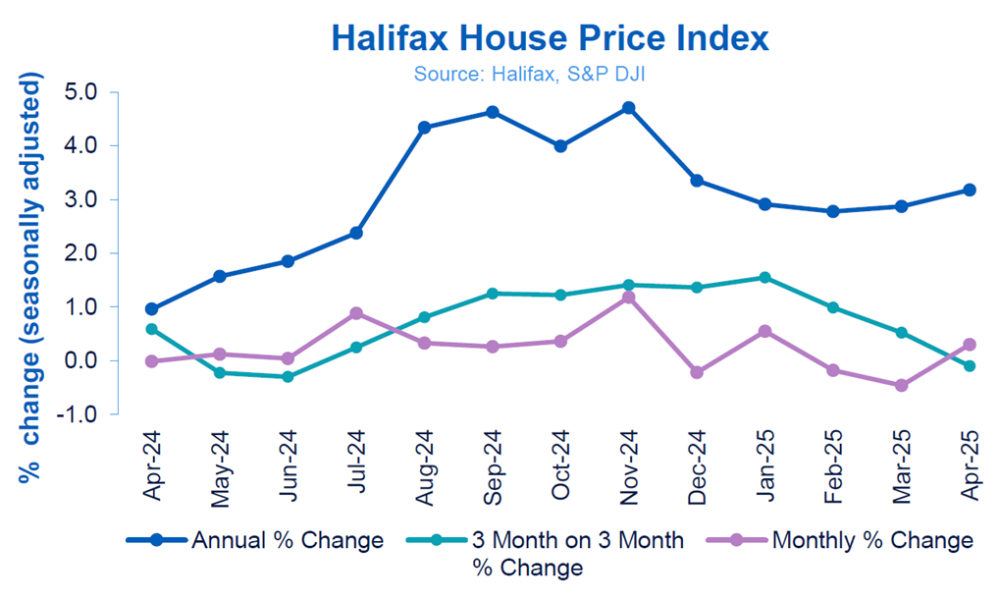Prices stable even after stamp duty-fuelled transaction spike

UK house prices rose slightly in April, with the average property now valued at £297,781, according to the latest data from Halifax.
The month-on-month increase of 0.3% equates to just under £900, while annual growth climbed to 3.2% - the highest yearly rate recorded so far in 2025.
The data suggests the market is stabilising after a rush in transactions earlier this year, driven by changes to stamp duty thresholds.
 “We know the stamp duty changes prompted a surge in transactions in the early part of this year, as buyers rushed to beat the tax-rise deadline,” said Amanda Bryden (pictured far left), head of mortgages at Halifax. “However, this didn’t lead to a significant increase in property prices, with the last six months characterised by a stability in prices rarely seen since the pandemic.”
“We know the stamp duty changes prompted a surge in transactions in the early part of this year, as buyers rushed to beat the tax-rise deadline,” said Amanda Bryden (pictured far left), head of mortgages at Halifax. “However, this didn’t lead to a significant increase in property prices, with the last six months characterised by a stability in prices rarely seen since the pandemic.”
Although activity has slowed slightly since the start of the year, buyer interest remains firm compared to recent trends. Falling mortgage rates — now below 4% at some lenders — and wage growth outpacing inflation have contributed to a more accessible market, Bryden noted.
“Overall, the market continues to show resilience despite a subdued economic environment and risks from geopolitical developments,” she said. “There is likely to be a bump-up in consumer price inflation as household bills increase, but with further base rate cuts also expected, we anticipate a similar trend of modest price growth this year.”
Propertymark chief executive Nathan Emerson (pictured second from left) said recent gains point to stable confidence in the market, particularly following the uptick in activity in recent weeks.
“This is a sign of sustained confidence in the UK’s housing market following a recent stamp duty surge in homebuying,” Emerson said, adding that seasonal patterns may further motivate sellers. However, he flagged the ongoing fragility in borrower sentiment, despite falling mortgage costs.
“Hopefully, the Bank of England can provide further clarity to aspiring homeowners when they meet later today.”
Rosie Hooper (pictured second from right), chartered financial planner at Quilter Cheviot, said the April data reflects a market recalibrating after a period of volatility.
“Much of the recent volatility in transaction activity was the result of buyers rushing to complete purchases ahead of the stamp duty threshold changes that took effect in April,” Hooper said. “Given the time it takes to finalise a property purchase, the April price data offers one of the clearest indications yet of how the market is functioning without the support of favourable stamp duty rates.”
Jean Jameson (pictured far right), chief sales officer at Foxtons, meanwhile, reported improving sentiment among buyers and sellers.
“The UK property market has stood firm so far this year, with property values up on both a monthly and annual basis in April, reversing the downward monthly trend observed in previous months,” he said.
Foxtons also noted more enquiries, an increase in listings, and higher deal volumes in recent weeks. Jameson expects the positive momentum to continue if mortgage costs remain affordable.
House price growth by region
Northern Ireland led annual price growth in April, up 8.1% year-on-year, with an average home now costing £208,220. Wales followed with 4.7% growth and an average price of £229,079. Scotland saw a 4.6% rise, with average values at £214,011.
In England, the North West posted the strongest growth at 4.1%, where homes are now priced at £240,975. London showed more modest gains of 1.3%, but remains the UK’s most expensive market at an average of £543,346.
The South West recorded the slowest annual increase at 0.9%, with average prices standing at £304,451.
Any thoughts on the latest Halifax House Price Index? Share them with us by leaving a comment in the discussion box at the bottom of the page.



